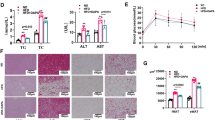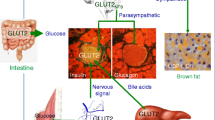Abstract
Adiponectin is a newly researched adipokine which participates in the regulation of energy homeostasis. AMP-activated protein kinase (AMPK) represents an energy sensor that responds to hormone and nutrition status in vivo and exerts a regulatory effect in the hypothalamus and multiple peripheral tissues. We investigated the possible mechanisms involved in appetite regulation by adiponectin in vitro with GT1-7 cells, a mouse immortalized hypothalamic neuron. The results showed that adiponectin increased the phosphorylation of AMPK, activated AMPK phosphorylated and inactivated acetyl-CoA carboxylase (ACC), and subsequently increased expression of agouti-related peptide (AgRP) mRNA. Our results also indicated that adiponectin had no effect on signal transducer and activator of transcription (STAT3). Together these findings suggest that adiponectin regulated energy homeostasis through the AMPK/ACC pathway but not the JAK/STAT3 pathway in the hypothalamus.





Similar content being viewed by others
References
Kola B, Boscaro M, Rutter GA et al (2006) Expanding role of ampk in endocrinology. Trends Endocrinol Metab 17(5):205–215. doi:S1043-2760(06)00084-1[pii]10.1016/j.tem.2006.05.006
Ceddia RB, Somwar R, Maida A et al (2005) Globular adiponectin increases glut4 translocation and glucose uptake but reduces glycogen synthesis in rat skeletal muscle cells. Diabetologia 48(1):132–139. doi:10.1007/s00125-004-1609-y
Wu X, Motoshima H, Mahadev K et al (2003) Involvement of amp-activated protein kinase in glucose uptake stimulated by the globular domain of adiponectin in primary rat adipocytes. Diabetes 52(6):1355–1363
Andersson U, Filipsson K, Abbott CR et al (2004) Amp-activated protein kinase plays a role in the control of food intake. J Biol Chem 279(13):12005–12008. doi:10.1074/jbc.C300557200C300557200[pii]
Minokoshi Y, Alquier T, Furukawa N et al (2004) Amp-kinase regulates food intake by responding to hormonal and nutrient signals in the hypothalamus. Nature 428(6982):569–574. doi:10.1038/nature02440
Hu Z, Cha SH, Chohnan S et al (2003) Hypothalamic malonyl-coA as a mediator of feeding behavior. Proc Natl Acad Sci USA 100(22):12624–12629. doi:10.1073/pnas.18344021001834402100[pii]
Steinberg GR, Watt MJ, Fam BC et al (2006) Ciliary neurotrophic factor suppresses hypothalamic amp-kinase signaling in leptin-resistant obese mice. Endocrinology 147(8):3906–3914. doi:en.2005-1587[pii]10.1210/en.2005-1587
Kitamura T, Feng Y, Kitamura YI et al (2006) Forkhead protein foxo1 mediates agrp-dependent effects of leptin on food intake. Nat Med 12(5):534–540. doi:nm1392[pii]10.1038/nm1392
Qi Y, Takahashi N, Hileman SM et al (2004) Adiponectin acts in the brain to decrease body weight. Nat Med 10(5):524–529. doi:10.1038/nm1029nm1029[pii]
Kubota N, Yano W, Kubota T et al (2007) Adiponectin stimulates amp-activated protein kinase in the hypothalamus and increases food intake. Cell Metab 6(1):55–68. doi:S1550-4131(07)00159-3[pii]10.1016/j.cmet.2007.06.003
Li B, Lee K, Martin RJ (2006) Overexpression of glucose transporter 2 in gt1-7 cells inhibits amp-activated protein kinase and agouti-related peptide expression. Brain Res 1118(1):1–5. doi:S0006-8993(06)02362-6[pii]10.1016/j.brainres.2006.08.032
Hu Z, Dai Y, Prentki M et al (2005) A role for hypothalamic malonyl-coA in the control of food intake. J Biol Chem 280(48):39681–39683. doi:C500398200[pii]10.1074/jbc.C500398200
Lee K, Li B, Xi X et al (2005) Role of neuronal energy status in the regulation of adenosine 5’-monophosphate-activated protein kinase, orexigenic neuropeptides expression, and feeding behavior. Endocrinology 146(1):3–10. doi:10.1210/en.2004-0968en.2004-0968[pii]
Lin L, Park M, York DA (2007) Enterostatin inhibition of dietary fat intake is modulated through the melanocortin system. Peptides 28(3):643–649. doi:S0196-9781(06)00439-6[pii]10.1016/j.peptides.2006.10.003
Wen JP, Lv WS, Yang J et al (2008) Globular adiponectin inhibits gnrh secretion from gt1-7 hypothalamic gnrh neurons by induction of hyperpolarization of membrane potential. Biochem Biophys Res Commun 371(4):756–761. doi:S0006-291X(08)00831-0[pii]10.1016/j.bbrc.2008.04.146
Carling D (2004) The amp-activated protein kinase cascade—a unifying system for energy control. Trends Biochem Sci 29(1):18–24. doi:S0968000403002986[pii]
Hardie DG (2004) The amp-activated protein kinase pathway—new players upstream and downstream. J Cell Sci 117(Pt 23):5479–5487. doi:117/23/5479[pii]10.1242/jcs.01540
Kemp BE, Stapleton D, Campbell DJ et al (2003) Amp-activated protein kinase, super metabolic regulator. Biochem Soc Trans 31(Pt 1):162–168. doi:10.1042/
Kahn BB, Alquier T, Carling D et al (2005) Amp-activated protein kinase: ancient energy gauge provides clues to modern understanding of metabolism. Cell Metab 1(1):15–25. doi:S1550-4131(04)00009-9[pii]10.1016/j.cmet.2004.12.003
Hawley SA, Pan DA, Mustard KJ et al (2005) Calmodulin-dependent protein kinase kinase-beta is an alternative upstream kinase for amp-activated protein kinase. Cell Metab 2(1):9–19. doi:S1550-4131(05)00166-X[pii]10.1016/j.cmet.2005.05.009
Ruderman NB, Saha AK, Kraegen EW (2003) Minireview: malonyl coA, amp-activated protein kinase, and adiposity. Endocrinology 144(12):5166–5171. doi:10.1210/en.2003-0849en.2003-0849[pii]
Price N, van der Leij F, Jackson V et al (2002) A novel brain-expressed protein related to carnitine palmitoyltransferase i. Genomics 80(4):433–442. doi:S088875430296845X[pii]
Wolfgang MJ, Kurama T, Dai Y et al (2006) The brain-specific carnitine palmitoyltransferase-1c regulates energy homeostasis. Proc Natl Acad Sci USA 103(19):7282–7287. doi:0602205103[pii]10.1073/pnas.0602205103
Faouzi M, Leshan R, Bjornholm M et al (2007) Differential accessibility of circulating leptin to individual hypothalamic sites. Endocrinology 148(11):5414–5423. doi:en.2007-0655[pii]10.1210/en.2007-0655
Peruzzo B, Pastor FE, Blazquez JL et al (2000) A second look at the barriers of the medial basal hypothalamus. Exp Brain Res 132(1):10–26
Loftus TM, Jaworsky DE, Frehywot GL et al (2000) Reduced food intake and body weight in mice treated with fatty acid synthase inhibitors. Science 288(5475):2379–2381. doi:8642[pii]
He W, Lam TK, Obici S et al (2006) Molecular disruption of hypothalamic nutrient sensing induces obesity. Nat Neurosci 9(2):227–233. doi:nn1626[pii]10.1038/nn1626
Gao S, Lane MD (2003) Effect of the anorectic fatty acid synthase inhibitor c75 on neuronal activity in the hypothalamus and brainstem. Proc Natl Acad Sci USA 100(10):5628–5633. doi:10.1073/pnas.10316981001031698100[pii]
Bates SH, Dundon TA, Seifert M et al (2004) Lrb-stat3 signaling is required for the neuroendocrine regulation of energy expenditure by leptin. Diabetes 53(12):3067–3073. doi:53/12/3067[pii]
Morton GJ, Cummings DE, Baskin DG et al (2006) Central nervous system control of food intake and body weight. Nature 443(7109):289–295. doi:nature05026[pii]10.1038/nature05026
Acknowledgments
This study was supported by the grants from Natural Science Foundation of China (No.30900510) and Fujian Youth Talent Project (2008F3032).
Author information
Authors and Affiliations
Corresponding authors
Additional information
Jun-Ping Wen and Chun-e Liu are equally contributed to this study.
Rights and permissions
About this article
Cite this article
Wen, JP., Liu, Ce., Hu, YT. et al. Globular adiponectin regulates energy homeostasis through AMP-activated protein kinase–acetyl-CoA carboxylase (AMPK/ACC) pathway in the hypothalamus. Mol Cell Biochem 344, 109–115 (2010). https://doi.org/10.1007/s11010-010-0534-2
Received:
Accepted:
Published:
Issue Date:
DOI: https://doi.org/10.1007/s11010-010-0534-2




